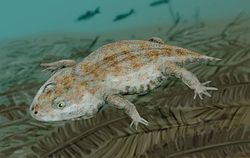| Amphibamiformes Temporal range: Probable descendant taxon Lissamphibia survives to present | |
|---|---|
 | |
| Amphibamus grandiceps | |
| Scientific classification | |
| Domain: | Eukaryota |
| Kingdom: | Animalia |
| Phylum: | Chordata |
| Order: | † Temnospondyli |
| Superfamily: | † Dissorophoidea |
| Clade: | † Amphibamiformes Schoch, 2018 |
| Subgroups | |
Amphibamiformes is an unranked clade with Dissorophoidea created by Schoch (2018). [2] It encompasses all of the taxa traditionally considered to be "amphibamids" (subsequently restricted to Doleserpeton annectens and Amphibamus grandiceps by Schoch), branchiosaurids, and hypothetically lissamphibians under the traditional temnospondyl hypothesis of lissamphibian origins. These taxa are typically small-bodied dissorophoids and form the sister group to Olsoniformes, which comprises dissorophids and trematopids.






